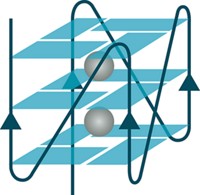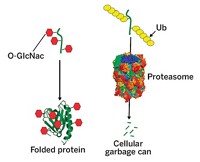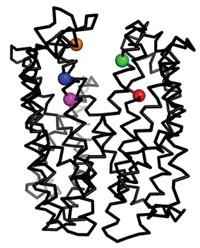Advertisement
Grab your lab coat. Let's get started
Welcome!
Welcome!
Create an account below to get 6 C&EN articles per month, receive newsletters and more - all free.
It seems this is your first time logging in online. Please enter the following information to continue.
As an ACS member you automatically get access to this site. All we need is few more details to create your reading experience.
Not you? Sign in with a different account.
Not you? Sign in with a different account.
ERROR 1
ERROR 1
ERROR 2
ERROR 2
ERROR 2
ERROR 2
ERROR 2
Password and Confirm password must match.
If you have an ACS member number, please enter it here so we can link this account to your membership. (optional)
ERROR 2
ACS values your privacy. By submitting your information, you are gaining access to C&EN and subscribing to our weekly newsletter. We use the information you provide to make your reading experience better, and we will never sell your data to third party members.
Biochemistry
New role in cells suggested for ATP
Known as an energy carrier, molecule can also solubilize proteins
by Jyllian Kemsley
May 18, 2017
| A version of this story appeared in
Volume 95, Issue 21
Adenosine triphosphate (ATP) performs many jobs in a cell. It carries energy, serves as a signaling molecule, and is the source of adenosine in DNA and RNA.
But cells contain far more ATP—as much as 5 mM in the cytoplasm—than these known uses seem to require. That might be because ATP also can solubilize proteins, suggests a new study (Science 2017, DOI: 10.1126/science.aaf6846).
ATP has the general characteristics of a hydrotrope, an amphiphilic molecule that has both a hydrophilic and a hydrophobic component but does not assemble into structures such as micelles. Hydrotropes are used industrially to solubilize hydrophobic species in aqueous solution. The hydrophobic portion of hydrotropes—such as ATP’s adenosine—likely interacts with the hydrophobic species, while the hydrophilic part—such as ATP’s triphosphate—allows the species to stay in solution.
In the new work, a team led by Yamuna Krishnan of the University of Chicago and Anthony A. Hyman of the Max Planck Institute of Molecular Cell Biology & Genetics investigated the effects of ATP on the aggregation of several proteins. They found that ATP could prevent the aggregation of two proteins known to form amyloid clumps. For a third protein, ATP was further able to dissolve fibers of already aggregated protein. And ATP kept proteins in boiled egg white from aggregating.
“Most healthy cell functions require that proteins remain soluble at enormous intracellular concentrations, without aggregating into pathogenic deposits,” write Allyson M. Rice and Michael K. Rosen of the University of Texas Southwestern Medical Center in a perspective accompanying the paper. “The cell may exploit a natural hydrotrope to keep itself in a functioning, dynamic state.”
ATP may have also played an important role in the origin and evolution of life, Krishnan, Hyman, and colleagues note in their paper. Aggregation would have been a problem even for early biological macromolecules. “ATP may have been coopted early in evolution to prevent such aggregation,” even before the molecule became an energy carrier, the researchers suggest.






Join the conversation
Contact the reporter
Submit a Letter to the Editor for publication
Engage with us on Twitter